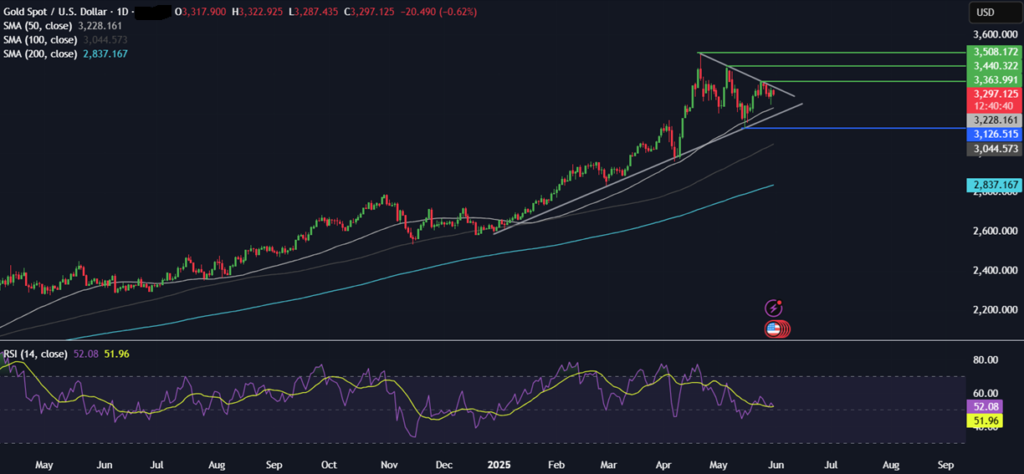Gold prices are set to fall 1.5% across the week after gains of almost 5% last week. While the precious metal has risen over 25% since the start of the year, momentum is clearly slowing with a gain of just 0.2% in May. Can Gold recover back up towards record highs?
After gaining steadily across the first quarter of the year, gold prices surged to a record high of $3500 on April 22 amid Trump’s trade tariff turmoil, but they have seen increased volatility since then. The Gold price dropped to a low of $3120 on May 15, and the recovery from that low has failed to hold above $3300.

Trump’s trade tariff headlines drive near-term moves.
Gold, a safe haven, has been supported by geopolitical uncertainty and concerns over slowing global growth amid Trump’s erratic trade policies. News surrounding Trump’s trade policies being blocked by the US International Trade Court and then unblocked following an appeal resulted in choppy trade. However, worst-case scenarios in the Trump trade war appear to have been averted so far.
The US and China have de-escalated the trade war, and Trump has delayed 50% trade tariffs on the EU until July 9 to allow time for negotiations. This has brought Gold back from record highs, although there is still an element of uncertainty surrounding tariffs, which keeps Gold supported. The precious metal is likely to continue to be driven by headline risk in the near term. Any sense that the trade war is escalating could lift Gold prices. Meanwhile, news of trade deals could see gold fall.
Weak economic data could lift Gold.
Poor data, which raises concerns over the economic outlook for the US, could support Gold prices higher. Yesterday’s disappointing US GDP and jobless claims could be an insight into weaker data coming. US GDP contracted by 0.2% annualised in the first quarter. However, consumer spending, which is a key driver of the US economy, fell to 1.2% from 1.8%, its lowest level in two years. Meanwhile, jobless claims also ticked higher. US core PCE data is due later today and is expected to cool to 2.5% YoY in April. However, this could be one of the last cooler inflation prints for a while.
Federal Reserve officials have warned that Trump’s trade tariffs are expected to slow growth, lift unemployment, and raise inflation. When hard data starts to show these impacts on the economy, demand for Gold could rise.
Central Bank demand
Central bank buying has been a strong driver of Gold prices, significantly increasing their Gold reserves, diversifying reserves, and increasing safe haven stores. Events like the Ukraine war, sanctions, and other geopolitical tensions have also contributed to central bank demand, which is expected to continue.
US debt worries
Finally, concerns over the US budget deficit will likely be another supporting factor over the longer term. Last week, the US sovereign credit downgrade and the passage of Trump’s sweeping tax cut bill helped drive US debt worries, lifting Gold 5%. Should Trump’s tax cuts be approved, worries about the US fiscal position could rise.
Conclusion
A de-escalation of Trump’s trade war has helped pull gold back from a record high, and headline risk could drive Gold near term. However, the downside in Gold appears limited, especially over a medium time frame, given expectations of slower growth, higher inflation, ongoing central bank purchases, and lingering concerns over the US budget deficit.
Trading involves risk.
The content provided here is for informational purposes only. It is not intended as personal investment advice and does not constitute a solicitation or invitation to engage in any financial transactions, investments, or related activities. Past performance is not a reliable indicator of future results.
The financial products offered by the Company are complex and come with a high risk of losing money rapidly due to leverage. These products may not be suitable for all investors. Before engaging, you should consider whether you understand how these leveraged products work and whether you can afford the high risk of losing your money.
The Company does not accept clients from the Restricted Jurisdictions as indicated in our website/ T&C. Some services or products may not be available in your jurisdiction.
The applicable legal entity and its respective products and services depend on the client’s country of residence and the entity with which the client has established a contractual relationship during registration.




